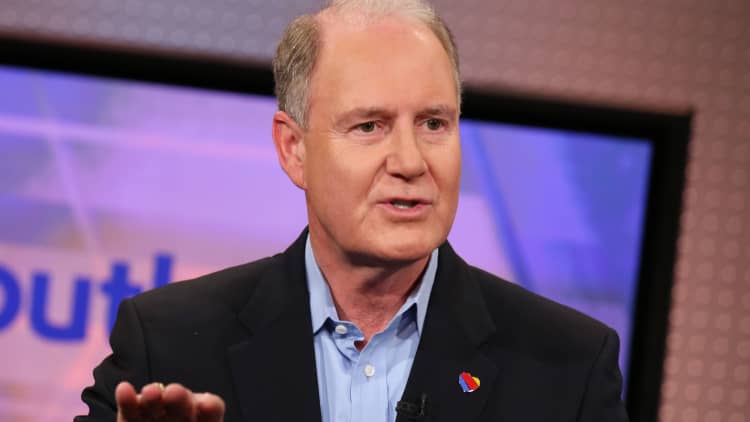U.S. airlines are starting to see an uptick in demand as the summer vacation season approaches, but a full recovery appears far off.
Southwest Airlines said Tuesday that new bookings are now outpacing cancellations, a turning point in the coronavirus pandemic that has devastated air travel demand.
The Dallas-based carrier has logged a "modest improvement" in demand and new bookings for next month. Southwest plans reduce its capacity by up to 55% next month from June 2019 and said that those flights will likely be between 35% and 45% full.
"The revenue environment remains uncertain and may require additional capacity reductions depending on passenger demand," it said in a filing. Southwest's shares gained 2.2% to end at $27.69.
The uptick is showing up at airports, too, but demand is still far from last year's levels for this time of year, when it generally rises. In the first 18 days of May, 3,419,717 people passed through security checkpoints at U.S. airports, according to the Transportation Security Administration, down 92% from a year ago but better than last month. The first 18 days of April showed a more than 95% decline on the year, TSA data shows.
Southwest forecast a drop of up to 90% in May revenue compared with 2019. The carrier previously expected a decline of up to 95%. Next month it expects its revenue to fall 80% to 85%.
United, for its part, said Tuesday that it has logged "a moderate improvement in demand" for trips within the United States and some international destinations in the rest of the second quarter. The airline is cutting capacity by 75% in July from a year ago, compared with a 90% year-over-year reduction planned for May and June.
United "plans to continue to proactively evaluate and cancel flights on a rolling 60-day basis until it sees signs of a recovery in demand."
It is also planning to more than halve its capital expenditures to around $2 billion next year. United's shares lost 1.9% on Tuesday, closing at $23.68.
American Airlines said during the investor conference that its planes are flying about 35% full, up from 15% in April. The airline's president, Robert Isom, said the carrier cut capacity by 80% in April and May.
Thanks to a rise in domestic leisure bookings in June and July, Delta Air Lines' net sales are up "modestly versus our conservative forecast," CFO Paul Jacobson said.
Jacobson said the airline is cautious until it has a better sense about what travelers are able to do once they get to their destinations. The airline is planning to increase international flying next month, including some flights to Shanghai, subject to government approval.
Getting travelers comfortable
The pandemic has presented airlines with a major challenge: How to get passengers who are worried about the virus comfortable with flying again?
U.S. airlines now require that passengers wear masks onboard and say they will make them available for travelers. But there are limits to what will be enforced. Airlines have told crews they don't have to force passengers to do so.
But some planes are more packed than travelers expect, sparking worries about social distancing onboard. After a photo of a packed United flight went viral earlier this month, the airline said it would start informing travelers if their flights are near capacity and allow them to change their trips or receive a credit.
Airline executives say worries about the virus aren't the only obstacle to getting many travelers back onboard. Tourist attractions like Disney World as well as restaurants and hotels also need to be open.
Delta's Jacobson, said during the conference on Tuesday that the airline is adding 100 flights in June so planes are no more than 60% full.
Potential job cuts
Major U.S. airlines have received portions of $25 billion in federal coronavirus aid that prohibits them from laying off workers or cutting their pay rates through Sept. 30. But because of weak demand, executives have begun warning that they expect to become smaller airlines and have urged employees to take voluntary leave or early retirement. That could mean workforce cuts after the federal aid restrictions expire.
More than 40,000 of Delta's roughly 90,000 employees have taken the company up on unpaid leaves ranging from 30 days to 12 months, Jacobson said. The airline is planning to offer buyouts and early retirements, too.
Jacobson said that "we hope that most of the head count changes that we're going to need are going to be achieved through these voluntary programs, and we can do that quickly."
American said that around 40,000 employees, close 30% of its staff, have opted for voluntary measures like reduced work schedules and partially paid leave.
"What we have to do is we have to right-size the airline from a cost perspective to make sure that what we fly next year is cash positive," said American Airlines CFO Derek Kerr. "So we're doing everything we can. We are going to look at all of the staffing in the fall, all the staffing next year. Everything that we do from a cost perspective is under review at this point in time."

Correction: An earlier version misstated the new capacity limit on Delta's planes.


